Introduction
Global trade is a cornerstone of modern economies, fostering economic growth, job creation, and innovation. However, trade disputes between nations are inevitable, arising from differing policies, practices, and interpretations of trade rules. The World Trade Organization (WTO) plays a critical role in resolving these disputes and ensuring a rules-based trading system. This article examines the nature of international trade disputes, the dispute resolution mechanism of the WTO, and the challenges facing the multilateral trading system.
The Nature of International Trade Disputes
Trade disputes occur when one country’s policies or actions are perceived to violate international trade agreements or unfairly disadvantage another country. Common causes of disputes include:
- Tariff and Non-Tariff Barriers: Imposing excessive tariffs or restrictive measures such as quotas and import bans.
- Subsidies and State Aid: Providing financial support to domestic industries in ways that distort competition.
- Intellectual Property Rights (IPR): Allegations of inadequate enforcement of IPR protections.
- Technical Barriers to Trade (TBT): Imposing standards and regulations that act as trade barriers.
- Dumping and Anti-Dumping Measures: Selling goods in foreign markets at prices below cost and imposing anti-dumping duties.
The Role of the WTO in Trade Dispute Resolution
The WTO provides a structured and impartial mechanism for resolving trade disputes under its Dispute Settlement Understanding (DSU). The system is designed to ensure that disputes are settled through legal and diplomatic means rather than unilateral actions or trade wars. Key features of the WTO’s dispute resolution process include:
- Consultations: The first step involves direct negotiations between the parties to resolve the dispute amicably.
- Panel Proceedings: If consultations fail, a panel of experts is established to examine the case and issue a report.
- Appellate Review: Parties can appeal the panel’s decision to the WTO’s Appellate Body, which provides a final ruling.
- Implementation and Compliance: The losing party is required to bring its measures into conformity with WTO rules or face authorized retaliatory measures.
Significant Trade Disputes and Precedents
Over the years, the WTO has adjudicated several high-profile trade disputes that have shaped international trade law:
- US – Steel and Aluminum Tariffs: The United States imposed tariffs on steel and aluminum imports citing national security concerns, prompting challenges from multiple countries. The dispute highlighted the tension between trade rules and national security exceptions.
- EU – Bananas Dispute: A long-standing dispute between the European Union and Latin American countries over preferential treatment for banana imports. The case underscored issues of trade preferences and market access.
- China – Rare Earths: China’s restrictions on the export of rare earth minerals were challenged by the United States, EU, and Japan. The WTO ruled against China, emphasizing the importance of free trade in critical materials.
Challenges Facing the WTO Dispute Resolution System
Despite its successes, the WTO’s dispute resolution system faces significant challenges:
- Appellate Body Crisis: The Appellate Body has been paralyzed since 2019 due to the United States blocking the appointment of new judges, citing concerns over judicial overreach. This has left the dispute resolution system without a functioning appeals process.
- Compliance and Enforcement: Ensuring compliance with WTO rulings remains a challenge, as countries may delay implementation or retaliate unilaterally.
- Complexity and Duration: The legal and technical complexity of disputes often results in lengthy proceedings, undermining the system’s efficiency.
- Evolving Trade Issues: Emerging challenges such as digital trade, climate-related trade measures, and pandemic-related restrictions require updated rules and interpretations.
Recent Efforts to Strengthen WTO Dispute Resolution
Efforts to address these challenges and strengthen the WTO’s dispute resolution system include:
- Multi-Party Interim Appeal Arrangement (MPIA): Several WTO members have established an alternative mechanism for appellate review in the absence of a functioning Appellate Body.
- Reform Proposals: Discussions on reforming the WTO include proposals to streamline dispute settlement procedures, address concerns over judicial overreach, and enhance transparency.
- Digital Trade Agreements: Initiatives to develop rules for e-commerce and digital trade aim to address gaps in the existing framework.
The Importance of a Rules-Based Trading System
The WTO’s dispute resolution system is a cornerstone of the multilateral trading system, ensuring that trade conflicts are resolved fairly and predictably. It upholds the principles of non-discrimination, transparency, and reciprocity, fostering trust among trading nations. A functioning and effective dispute resolution mechanism is essential for addressing trade tensions and maintaining the stability of the global economy.
Conclusion: Strengthening WTO’s Role in Trade Disputes
International trade disputes are an inevitable consequence of economic globalization. The WTO’s dispute resolution system provides a critical mechanism for resolving these conflicts and upholding the rules-based trading order. While the system faces significant challenges, including the Appellate Body crisis and evolving trade issues, ongoing reforms and international cooperation offer pathways to strengthening its effectiveness. By adapting to new realities and preserving its core principles, the WTO can continue to play a vital role in facilitating fair and open global trade.














